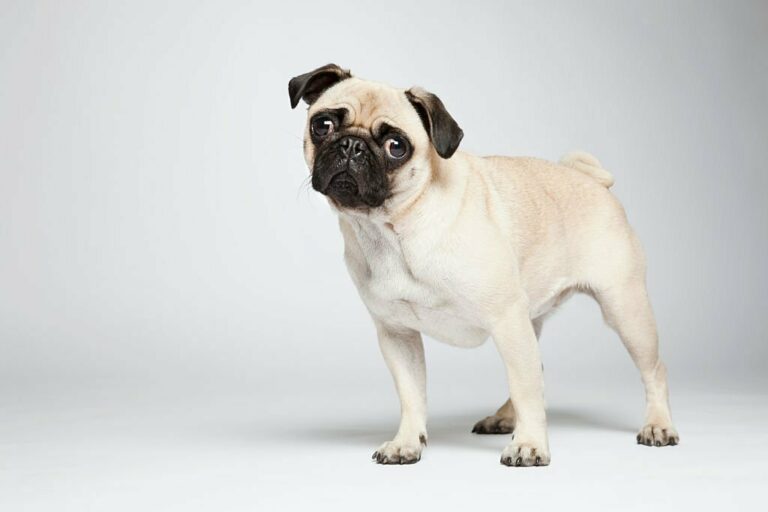Pug Dog Breed Information and Temperament
Pugs are an affectionate and famous dog breed known for their distinctive wrinkled face and curled tails. From their origins to their health conditions and grooming needs, there’s much to learn about these little dogs.
Key Takeaways
- Pugs originated from China and charm Europe via Dutch trade.
- Social and affectionate, Pugs need interaction and regular exercise.
- Potential health issues in Pugs require consistent veterinary care.
Quick Facts
Pugs are loved for their playful nature and friendly temperament. These small dogs usually stand about 10 to 13 inches tall and weigh 14 to 18 pounds.
Known for their distinctive looks and originating from China, Pugs sport a sleek, shiny coat commonly seen in fawn or black. Their short snout and deep facial folds contrast with a robust, square-shaped body. A notable feature of Pugs is their tight, curled tail that rests above their backside.
Thanks to these charming qualities and their friendly nature, Pugs consistently maintain a strong presence in popular dog breed rankings, such as the American Kennel Club.
Pug Pictures
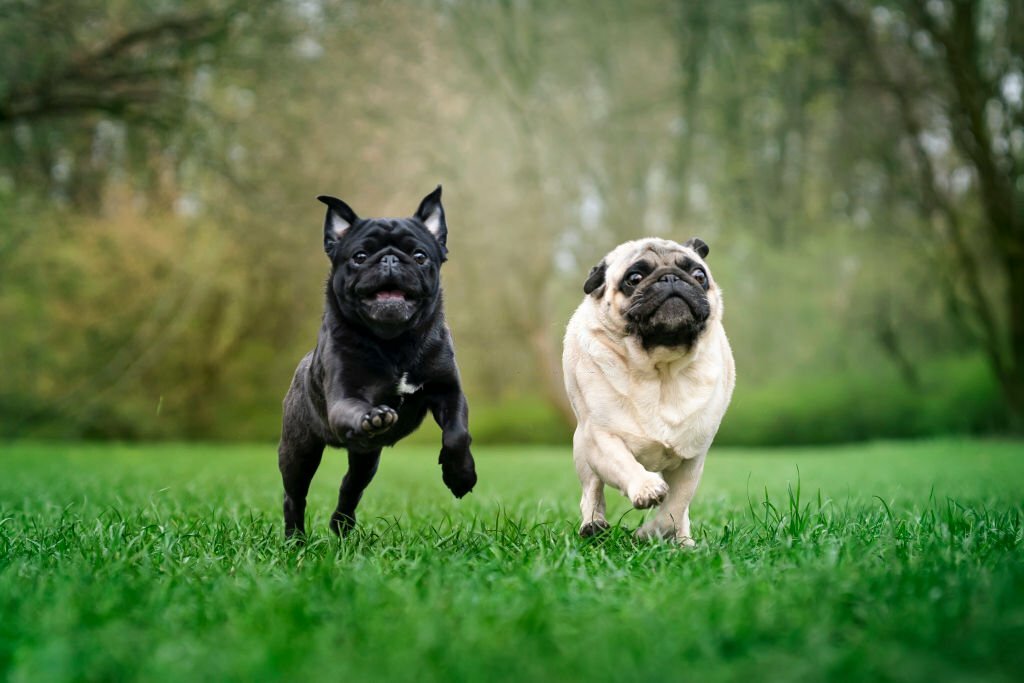
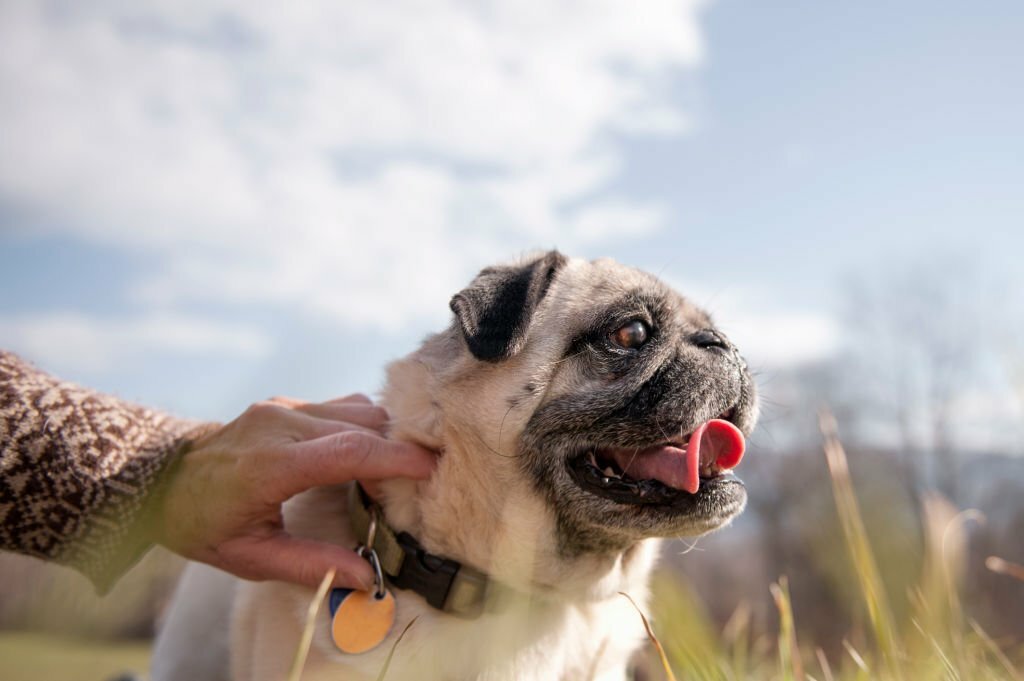
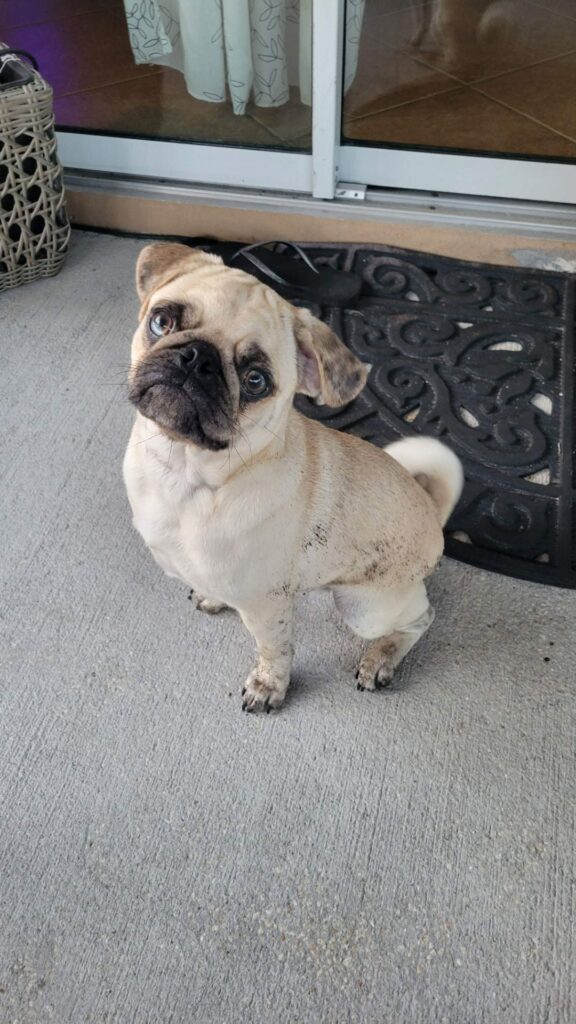
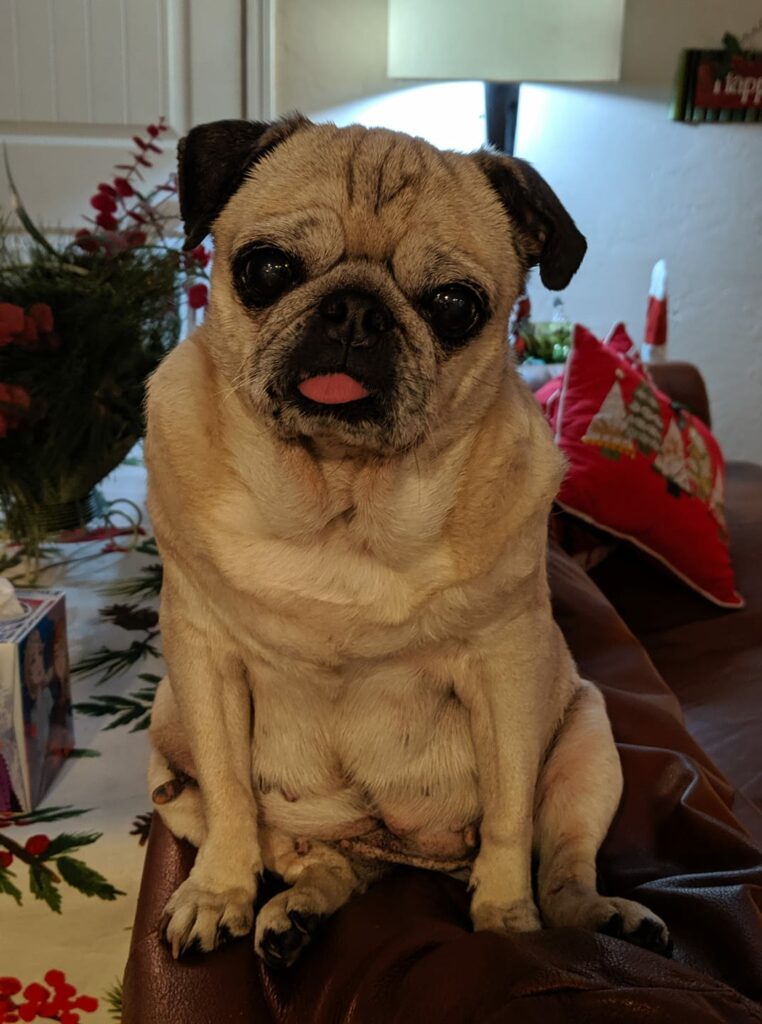
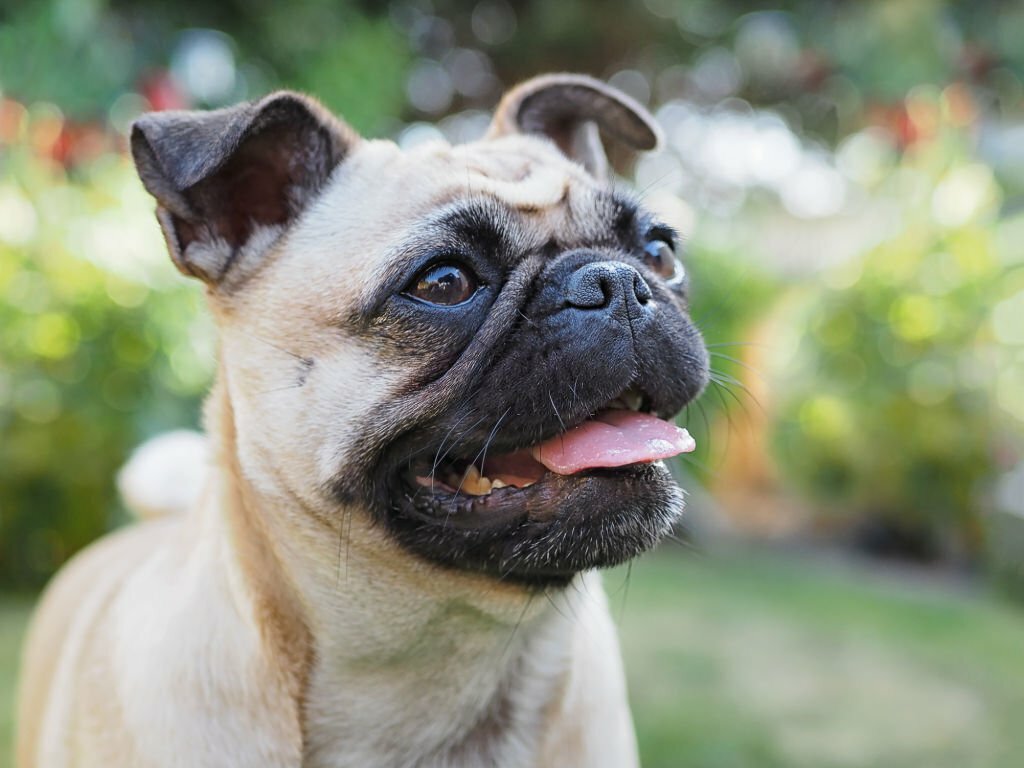
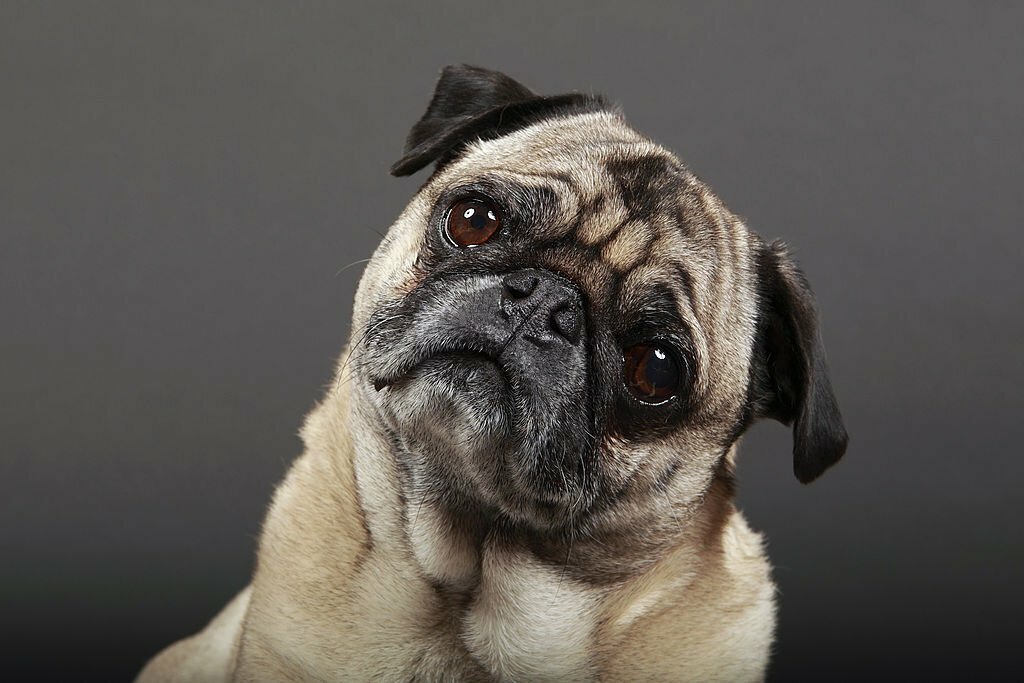
Overview
Pugs are charming and versatile pets, perfect for various home environments due to their friendly and adaptable nature. These small dogs stand about 10 to 13 inches tall and weigh 14 to 18 pounds. They have a distinctive appearance with their wrinkled faces, curled tails, and shiny short coats that come in colors like fawn and black.
Originating from China’s Imperial courts during the Shang dynasty, emperors treasured pugs and had a regal history.
As part of the Toy Group, pugs are known for being very social and loving. Yet, they are susceptible to health issues such as eye injuries, breathing difficulties, obesity, and dermatitis in their skin folds. Owners should be aware of these potential problems and provide proper care to keep their pugs healthy and happy.
Key Traits
Pugs are known for their friendly and loving nature, making them perfect family pets. They have a sturdy and compact build, with a smooth, shiny coat that’s easy to care for. Their black muzzle stands out, especially on lighter-colored pugs, and their facial wrinkles require regular cleaning to maintain their health.
| Trait | Description | Significance |
|---|---|---|
| Friendliness | Very loving, enjoys being around people | It makes for a great family pet |
| Tail | Curled tightly, sometimes a double curl | Signature look for the breed |
| Coat and Muzzle | Short, sleek coat; muzzle is dark | Low-maintenance fur; distinctive face |
This overview highlights the Pug’s charming qualities and the care they need. It paints a clear picture of what makes these dogs unique and the joy they bring to their owners.
Historical Development
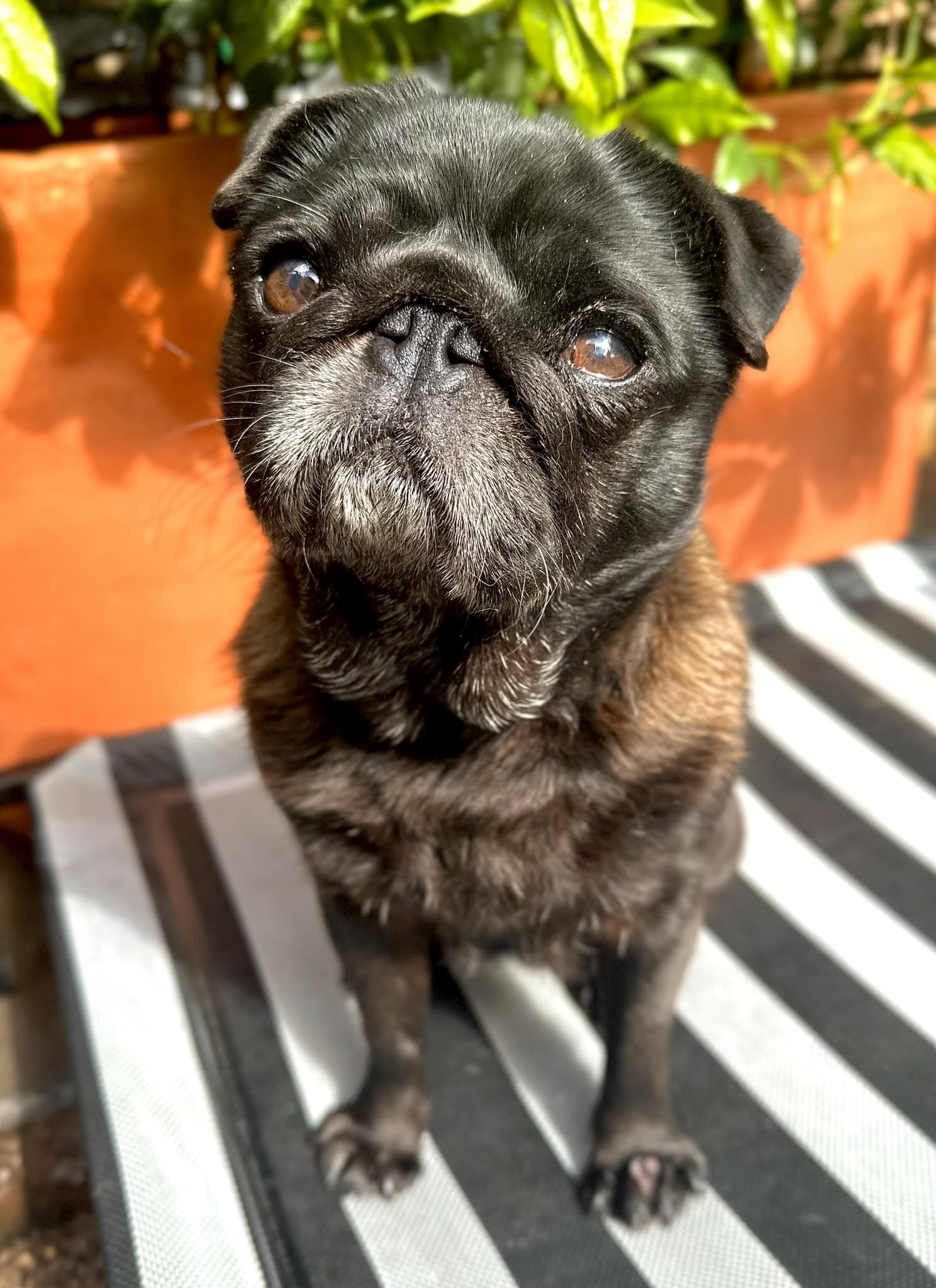
The pug breed has an illustrious history, starting as a treasured pet among Chinese emperors. They were bred for unique features like their short snout and curly tail.
The Pug then made its way to Europe, where Dutch traders introduced it to the upper echelons of society. Here, pugs became associated with the House of Orange and earned the affection of various European royal families.
In recent years, pugs have experienced a significant increase in popularity, becoming favored pets once more. Their endearing faces and personalities have captured people’s hearts worldwide, and they frequently appear in various forms of media, further cementing their status as beloved cultural icons.
Chinese Ancestral Roots
Pugs have a long history that dates back to the Shang dynasty in China, around 1600 to 1046 BCE. They were prized by Chinese emperors and bred to meet the tastes of high society, with their compact size, distinct facial features, and curled tails.
These dogs served as regal companions and symbols of wealth and status in the royal circles. When pugs arrived in Europe, they quickly became favorites among the aristocracy, including the House of Orange, showcasing their timeless charm and significance in different cultures.
European Noble Favourite
When pugs arrived in Europe during the 16th century, they quickly became beloved pets among the elite. Their unique facial features and personalities matched the tastes of high society, leading to their adoption by the House of Orange.
As William III and Mary II took the English throne, pugs became prominent, often shown in portraits with their noble owners. These images highlight the breed’s association with luxury and status.
The Pug’s steady popularity with nobility through the years speaks to its lasting charm as a symbol of elegance.
Modern Popularity Surge
Pugs have always been seen as a symbol of high status, but their popularity soared with their appearances in the media, like the memorable ads by Vodafone in India. Queen Victoria’s love for pugs boosted their high-class image, which played a role in forming the Kennel Club.
Around the same time, owning black pugs became a sought-after trend, a preference that we still see today. The breed’s prestige was further established when the American Kennel Club recognized it, securing its place among esteemed dog breeds.
Their regal history and modern media fame have made pugs a beloved breed worldwide. They maintain a strong presence in various forms of media, appreciated for their noble background and relevance in today’s culture.
Physical Stature Details
Pugs are small, sturdy dogs known for their charming looks and friendly nature. They typically stand about 10 to 13 inches tall and weigh between 14 and 18 pounds. Their expressive faces are defined by deep wrinkles and big, dark eyes, often conveying a wide range of emotions. Due to their facial structure, pugs are prone to brachycephalic syndrome related to their short nasal passages.
Their coats are smooth, refined, and glossy, with fawn and black being the most common colors. The tail of a Pug is another distinctive feature, curling tightly over its hip due to genetic factors that shape its form.
Pugs need regular grooming to keep their wrinkles clean and their skin healthy. Owners should be vigilant for skin irritation or infection signs to ensure their Pug remains comfortable and happy.
Breed Size Range
Pugs might be small, standing just 10 to 13 inches tall at the shoulder, but they’re pretty sturdy. Weighing in at 14 to 18 pounds, these small dogs have a compact build and well-muscled body supported by solid, straight legs.
Despite their strength, pugs aren’t too active and can quickly add extra weight. Owners should closely monitor their diet to keep them healthy and prevent obesity.
Distinctive Facial Features
Pugs have a look that separates them, thanks to deep wrinkles and a short, broad muzzle. These compact dogs have a flat-faced cranial structure, known as brachycephaly, which gives them their unique look. Caring for their wrinkled skin is vital to avoid skin problems.
Their big, round eyes add to their expressive faces and make them prone to eye conditions. Narrow nostrils, or stenotic nares, can make breathing difficult for pugs, a common issue in flat-faced breeds. They also have an underbite, where the lower teeth just past the upper ones, shaping their distinctive smile and necessitating regular dental care.
Coat Types, Colors
Pugs are known for their distinctive, shiny coats, mainly in fawn and black. The fawn shades range from a light cream to a warm apricot, while the black coats are a deep, uniform black without any other markings. Pugs with fawn coats often have a well-defined ‘mask’ that adds to their unique facial expressions.
Adhering to the breed’s standards, the fawn and black coats should be clear and distinct in color, with a smooth texture and close to the body. This coloration is spread evenly over their compact, sturdy build, showcasing the physical traits that pugs are loved for.
Tail Curl Variations
Pug tails come in shapes from a gentle curve to a tight double coil, adding to their unique silhouette. These variations are a recognized part of the pug breed standard and play a role in judging their conformation.
While the curled tail is a signature feature, it’s also linked to spine issues like hemivertebrae, which can lead to discomfort and problems moving. Breeders work to balance the breed’s look with the dogs’ health, carefully monitoring tail curls to ensure they don’t compromise the pugs’ quality of life.
Wrinkle Care Essentials
Taking care of your Pug’s unique wrinkles is vital for their health and well-being. These deep folds can trap bacteria and yeast, which may lead to skin conditions like dermatitis. To prevent these issues, you should clean the wrinkles regularly. A soft, damp cloth works well to clean these areas, and it’s crucial to dry them properly afterward to keep the skin free from excess moisture, which can promote the growth of harmful pathogens.
Pugs’ facial structure also puts them at risk for eye problems, such as corneal ulcers, due to irritation from their skin folds. Keeping the wrinkles clean helps to prevent these issues. Additionally, pugs have a unique immune system that may leave them prone to skin conditions like demodectic mange. Regular wrinkle care can also support their respiratory health, as untreated infections in the nasal folds can worsen breathing, a common issue for dogs with short muzzles.
Behavioral Traits
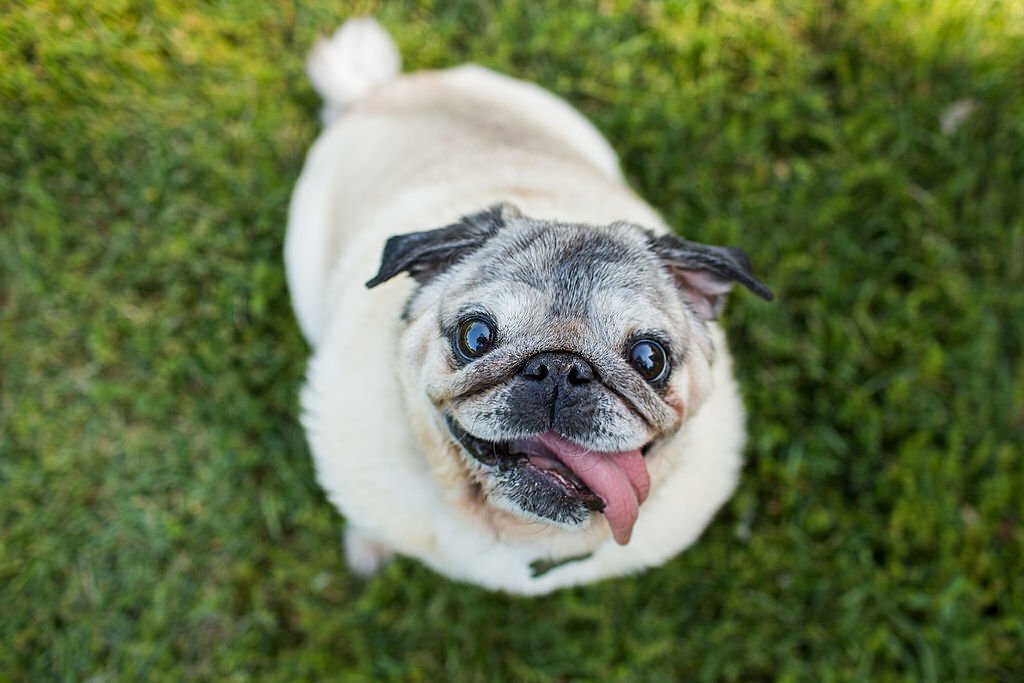
Pugs have a range of behavioral traits that owners need to understand. Knowing how to handle these behaviors ensures a happy life for the dog and its family. Let’s discuss what it takes to shape a well-behaved Pug.
Socializing your Pug is vital. Exposure to different people, animals, and environments helps them become well-adjusted and friendly. This exposure impacts their temperament and ability to cope with new situations.
Training a Pug can be a bit of a challenge due to their stubborn nature. However, patience and consistent training can lead to good behavior. Using positive reinforcement and setting clear boundaries can make a significant difference.
Managing a Pug’s prey drive involves understanding what excites them. Once you know what grabs their attention, you can use training to moderate their instinctive reactions. This keeps both the Pug and other animals safe.
Socialization Needs
Socialization is critical for Pugs, helping them grow into friendly and sociable pets. These dogs crave human company and benefit from meeting different people and animals early to prevent negative habits.
Pugs love to play, which is excellent for bonding and keeping them fit, supporting their physical health and behavior. They are especially great with kids due to their gentle and patient nature.
Regular socializing makes Pugs more adaptable and fits well with their intuitive and empathetic personalities.
Training Challenges
Training Pugs requires understanding their smart but stubborn nature. Early detection of signs pointing to pug dog encephalitis (PDE) is vital since it could affect their learning.
Pugs tend to gain weight, making training more difficult and leading to more behavior problems. A balanced diet is vital to keeping their weight and brain health in check.
Health issues can change a Pug’s mood and how well they respond to training, so combining good health care with behavioral training is essential. This approach is necessary to train a Pug, considering their unique challenges successfully.
Prey Drive Management
Pugs have an instinct to chase after small animals and fast-moving objects. Owners must carefully train their dogs to prevent this from becoming unwanted behavior. Introducing a pug to different animals and situations early on helps reduce their urge to chase.
Without enough mental and physical stimulation, a pug’s chase instinct can become more robust. Regular walks and interactive games can help channel this energy into positive activities. This prevents issues with other pets and supports the dog’s overall well-being, which is vital for a harmonious home life.
Separation Anxiety Tendencies
Pugs often struggle with separation anxiety, becoming distressed and acting out when their owners leave them alone. They crave human company and may act out if left alone or confined. The Pug Dog Club emphasizes the need for continuous interaction and suggests methods to make pugs more comfortable alone.
For example, pugs kept inside often seek physical contact and want to stay close to their people. To help them cope better with being alone, it’s important to gradually get them used to it and prevent any destructive behavior.
A well-thought-out plan for keeping them entertained and sticking to a regular schedule can significantly reduce their stress when they’re by themselves.
Aggression Indicators
Pugs are generally friendly and calm dogs, but like any breed, they can show signs of aggression, such as growling, snapping, or backing away. These behaviors may be unusual for pugs, bred to be friendly companions, unlike dogs like Pit Bulls that were selected for their physical prowess.
Pugs can still be protective and make alert watchdogs within a home setting. When a pug shows signs of aggression, it’s essential to understand the situation and what might be causing these reactions. Stress or health problems could be contributing factors, and a vet visit can help determine the cause of such changes in behavior.
Wellness & Medical Concerns
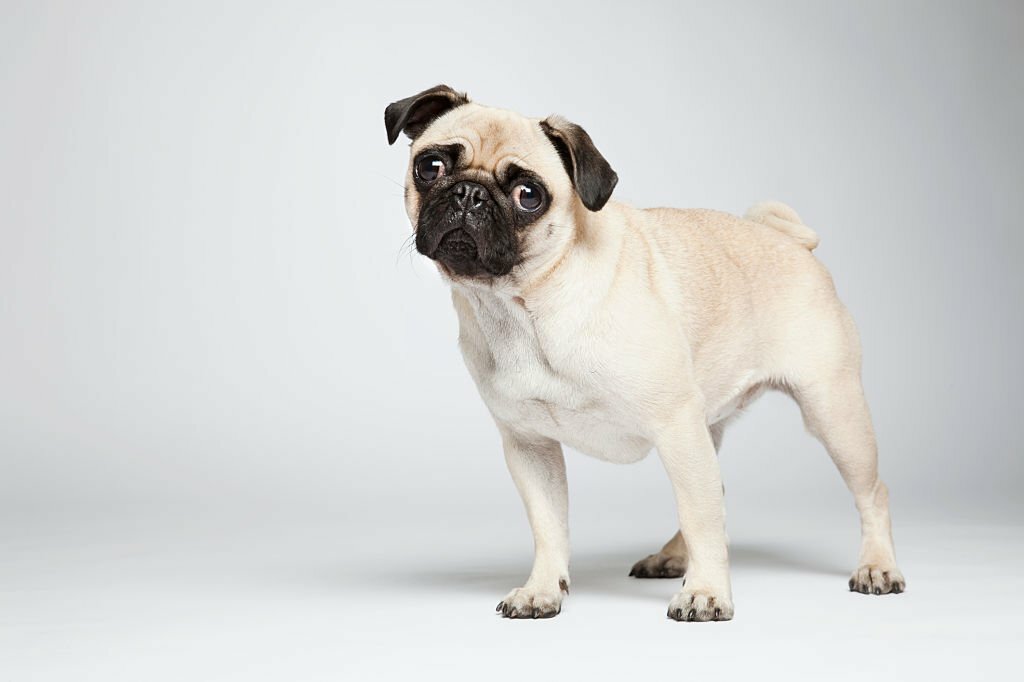
Pugs have distinct health and wellness needs that owners should attentively manage. To keep these charming dogs healthy, it’s essential to recognize their common health issues, take preventive measures, and know how to handle severe conditions.
Health Challenges Pugs Face
Two significant health problems in pugs include Brachycephalic Airway Obstructive Syndrome (BAOS), which affects their breathing, and Necrotizing Meningoencephalitis (NME), a severe brain condition. They also often suffer from eye problems due to their prominent eyes.
Keeping Pugs Healthy
Regular check-ups are vital to catching any health issues early. Consistent grooming and maintaining a healthy weight through a proper diet are also essential. These steps help prevent problems before they start.
Managing Pug Health Conditions
Treatments may involve surgery, medication, or even physiotherapy if a pug develops a severe condition. A supportive environment and careful monitoring are crucial for managing these conditions and maintaining quality of life.
Common Health Issues
Pugs often face health challenges, especially related to their eyes and breathing. Their bulging eyes can lead to conditions like proptosis, where the eye pops out of the socket, and entropion, which causes the eyelid to roll inward and irritate the cornea.
They may struggle with their breathing due to the structure of their short faces, a condition known as brachycephalic obstructive airway syndrome, which also makes it hard for them to stay calm.
These dogs are also prone to hip dysplasia, where a poorly formed hip joint can cause arthritis; the Orthopedic Foundation for Animals has noted this. Lack of exercise can lead to pug obesity, worsening their health problems.
On rare occasions, they might develop encephalitis, a brain inflammation that requires immediate vet care.
Preventative Care Strategies
Pug owners must prioritize preventative health measures to ensure their pets’ well-being. Keeping pugs at a healthy weight is critical, as excess pounds can lead to breathing difficulties in this breed. Due to their unique facial structure, pugs benefit from moderate exercise to avoid overworking their respiratory system.
It’s also vital to protect pugs from harsh weather conditions; both heat and cold can cause them serious health problems. Regular eye checks are necessary to prevent any potential injuries, given the prominence of their eyes.
Starting from a young, pugs should have consistent veterinary visits to catch and address breed-specific issues early on.
Serious Condition Management
Caring for pugs with health issues demands vigilant management and a quick response to their health needs.
Owners must control the environment carefully because pugs don’t handle extreme temperatures well.
To manage health problems effectively, strategies should be tailored to support the dog’s breathing abilities without overwhelming them.
Monitoring their food is vital to keep them healthy and prevent weight gain.
Regular vet check-ups are essential, too, to check for breathing issues, encephalitis, and spinal problems, treating them promptly to prevent further health decline.
Maintenance & Grooming
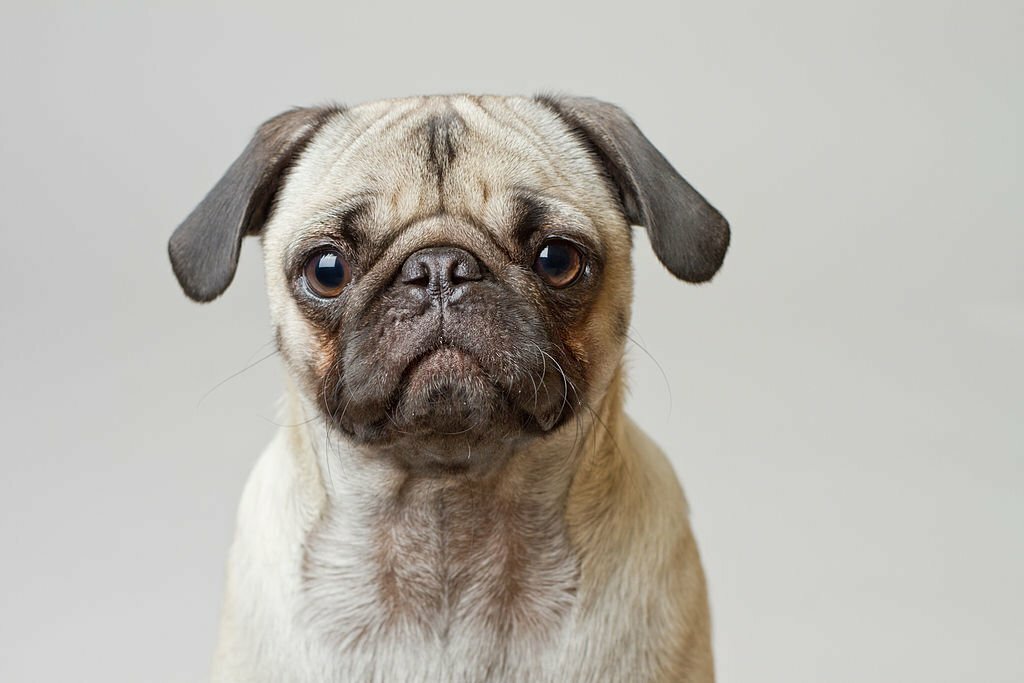
Caring for your Pug’s coat and skin is essential to keep them healthy and looking their best. Regular grooming helps manage shedding and maintain their skin condition.
To deal with shedding, use specialized tools to remove loose fur efficiently. Create a grooming schedule that matches your Pug’s natural shedding pattern. Adjust the grooming frequency based on your pet’s unique needs and environment. Regular baths and brushings help keep their coat clean and reduce the amount of hair around your home.
Pay close attention to the skin folds on your Pug’s face. Clean these areas carefully to prevent infections or dermatitis. Keep an eye out for any signs of discomfort or irritation, as these can indicate a problem that might need a vet’s attention.
A well-planned grooming routine keeps your Pug looking good and supports their health and happiness.
Shedding Management
Managing your Pug’s shedding can be straightforward with the right approach to grooming. Regular brushing is vital to keeping their coat healthy and reducing hair around the house. A good brush-out picks up loose fur and promotes a healthy skin condition, especially considering a pug’s short, sleek coat. Special brushes made for short-haired dogs can make grooming more effective.
During grooming sessions, pay extra attention to the legs and the lower jaw area to prevent hair buildup and promote cleanliness. A gentle cleaning routine focusing on hygiene helps preserve your Pug’s unique features, such as the dark line on their back and those charming beauty spots. This routine doesn’t just minimize shedding; it also protects their skin and coat from potential issues.
Grooming Frequency
Grooming your Pug every few weeks is critical to maintaining skin and coat health. These charming dogs have a smooth, shiny coat that doesn’t need as much attention as other breeds.
Pugs, known for being great companions, also have a simple grooming routine. Both the American Kennel Club and the Canadian Kennel Club advise cleaning your Pug’s facial wrinkles regularly to avoid skin infections.
Regular brushing can keep their moderate shedding under control, and bathing them occasionally will keep them clean and fresh. It’s also important to clean their ears, trim their nails, and care for their teeth to avoid health problems common in pugs.
Skin Fold Care
Taking care of your Pug’s skin folds is vital to their grooming routine. Keeping these areas clean is necessary to prevent issues like skin fold dermatitis.
The American Kennel Club emphasizes routine cleaning to stop the buildup of moisture and bacteria that could cause infections. A gentle wipe with a moist, soft cloth and ensuring the folds are dry will help maintain your Pug’s skin health.
It’s also beneficial to use vet-approved products to keep the skin’s pH balanced and minimize irritation. With their unique facial structure and origins in China, Pugs require careful attention to detect any inflammation or infections early on, allowing quick treatment.
Nail Trimming Importance
Regular nail trimming is vital for your Pug’s well-being, as long nails can cause pain and difficulty walking. Letting a pug’s nails grow too long can negatively affect their posture and lead to joint problems.
Pug owners should keep a consistent nail clipping schedule to support their pet’s health and comfort. This grooming task goes beyond aesthetics; caring for your Pug’s physical condition is necessary.
One famous Pug, Fortune, was even part of a royal household, showing that these dogs have a history of being well-cared for, with nail care an essential aspect of their grooming.
Brushing Techniques
Proper brushing is vital for keeping a Pug’s coat healthy, helping to get rid of loose hair and spreading their skin’s natural oils.
A soft bristle brush works best for maintaining their short, smooth coat. Brushing them often is essential to prevent their fur from tangling and keep their strong body shape looking good.
Cleaning a Pug’s face wrinkles well is essential to prevent skin infections caused by trapped moisture and dirt. Regular teeth cleaning is necessary since Pugs can have dental problems due to their under-bite.
Also, keeping their rose or button ears clean is vital to avoid ear problems.
Dietary Requirements
Pugs need a well-balanced diet to stay healthy and full of energy. Identifying and handling food allergies is critical to keep their skin and digestive system in good shape. Keeping pugs at a healthy weight is also crucial to prevent other health issues.
- Balanced Nutrition
- Include enough protein to support muscle health.
- Add essential fatty acids for a shiny coat and healthy skin.
- Provide vitamins and minerals to support their overall metabolism.
- Managing Food Allergies
- Watch for signs of allergies to common ingredients like grains or specific proteins.
- Try an elimination diet to find out what’s causing the problem.
- Consider hypoallergenic food options for sensitive pugs.
- Preventing Obesity
- Keep an eye on how many calories your Pug eats.
- Please make sure they get plenty of exercise.
- Practice portion control and pick healthy snacks for them.
Optimal Nutrition Balance
Pugs need a well-balanced diet with proteins, carbs, fats, vitamins, and minerals. This mix supports their muscle health and helps prevent obesity—a common issue in the breed. Proteins should be high to keep their muscles strong, but carbs must be checked to avoid unnecessary weight gain.
Fats, specifically essential fatty acids, are critical for a shiny coat and healthy skin. Yet, monitoring the fat content is necessary to avoid making your Pug overweight. Antioxidants and specific vitamins are essential, too—they help protect their eyes from diseases pugs are prone to.
Always consult a vet to tailor your Pug’s diet to their specific health needs and metabolism to keep them in tip-top shape as they age.
Food Allergy Considerations
When planning a diet for a pug, food allergies must be taken into account. Recognizing what foods may cause harmful immune reactions is crucial in keeping these dogs healthy.
Pugs with food allergies can suffer from skin issues like itching, ear infections, and digestive problems such as diarrhea and vomiting. To identify the culprit, vets usually suggest an elimination diet, where foods are removed and then slowly reintroduced one at a time.
Nutritionists might advise feeding pugs with unique or hydrolyzed proteins to reduce allergic reactions. Monitoring the Pugs’ health and tweak their diet to support their well-being is vital.
Obesity Prevention Strategies
Pug owners must proactively prevent obesity in their pets due to the breed’s tendency to gain weight. A well-planned diet that limits calories is crucial for these dogs. It’s beneficial for pugs to eat high-quality protein to maintain their muscle mass while keeping a balance of carbohydrates and fats to fulfill their energy needs without going overboard. Controlled feeding times and measured meal portions can help avoid the risk of overfeeding.
It’s wise to include fiber-rich foods in their meals to support a feeling of fullness and digestive health. Regular checks on your Pug’s weight and body shape are important, and when necessary, consult your vet to make the right dietary changes. This proactive approach helps to prevent obesity and the health issues that come with it.
Additional Information About Pugs
Pug dogs were believed to be favored by the royal families in China and later the House of Orange in Europe. Their association with royalty adds to their charm and character.
Physical Characteristics of Pug Dogs
Pugs are small, like a puppy, with distinctive square-shaped, wrinkled faces and tightly curled tails. Their short coat and prominent muzzle make them an easily recognizable breed among dog enthusiasts.
Personality Traits of Pug Dogs
Known for being affectionate and charming, pugs make excellent companions. Their playful nature and tendency to form strong bonds with their owners have endeared them to many pet parents around the world. They rarely bark.
How to Groom a Pug Dog?
Grooming a pug involves regular brushing to maintain their short coat and cleaning their facial wrinkles to prevent infections. Essential grooming, such as nail trimming and ear cleaning, is also critical to their well-being.
Brushing Pug’s Coat
Pugs have a short, smooth coat that requires regular brushing to minimize shedding and keep their fur in good condition.
Cleaning Pug’s Wrinkles
The deep facial wrinkles of pugs need regular cleaning to prevent the accumulation of dirt and moisture, which can lead to skin issues.
Essential Grooming for Pug Dogs
Aside from brushing and cleaning their wrinkles, pug grooming involves nail trimming, ear cleaning, and dental care to maintain their overall hygiene.
Understanding the Temperament of Pug Dogs
Pugs are known for their affectionate nature and are often seen as lap dogs due to their preference for close contact with their owners. Understanding their energy levels and addressing separation anxiety is essential for their well-being.
Affectionate Nature of Pug Dogs
Pugs are affectionate and enjoy companionship, making them ideal pets for individuals or families looking for a loyal and loving companion.
Dealing with Pug’s Energy Levels
Despite their small size, pugs have moderate energy levels and enjoy participating in dog sports to keep them physically and mentally stimulated.
Dealing with Separation Anxiety in Pug Dogs
Pugs are prone to separation anxiety and may exhibit stress-related behaviors when left alone for extended periods. You provide them with comfort and a safe environment when alone, which is essential for their mental well-being.
What are the Health Conditions of Pug Dogs?
Pugs are prone to various health issues due to their brachycephalic features and are susceptible to obesity and breathing problems. Preventive care and regular veterinary check-ups are crucial for maintaining their health.
Common Health Issues in Pug Dogs
Pugs are known to have breathing difficulties and obesity and are susceptible to conditions such as Pug Dog Encephalitis (PDE) and respiratory issues due to their brachycephalic nature.
Preventive Care for Pug Dogs
Regular exercise, a balanced diet, and preventive measures such as dental care and parasite control are essential to mitigate potential health issues in pugs.
Dealing with Pug’s Breathing Problems
Pugs’ short muzzles and compact airways can lead to breathing challenges, making monitoring their activity levels and avoiding overly strenuous activities important.
Why are Pugs Popular Among Pet Parents?
Pugs have secured their position as a popular dog breed due to their lovable nature and distinct features. Their endearing personality traits and historical significance make them a beloved choice for pet parents.
Pug Dogs as a Popular Dog Breed
Their unique appearance, playful demeanor, and established presence throughout history have contributed to the popularity of pugs as a preferred dog breed among pet owners.
Why Pet Parents Love Pugs
Many pet parents are drawn to pugs’ charming and loyal nature, making them a popular choice for individuals and families seeking a friendly and devoted companion.
Personality Traits That Endear Pugs to People
The affectionate and amiable disposition of pugs and their adaptability to various living environments have endeared them to countless individuals, cementing their position as a cherished dog breed.
Pugs are small, charming dogs with a history tracing back to China, and they became widely known in Western Europe thanks to Dutch traders. They stand out with their short, wrinkled faces and big, soulful eyes, topped with a twisty tail. These dogs may be small but have a solid build and huge heart.
Being incredibly social and loving, Pugs thrive on human interaction and are known for their loyalty to their families. They love to play and can often be found getting up to some harmless mischief. While they’re well-suited for apartment living, they still need daily walks and activities to keep their minds sharp.
If you’re considering welcoming a Pug into your home, remember they have some health issues to watch out for, like breathing and eye problems, so regular vet visits are necessary.

